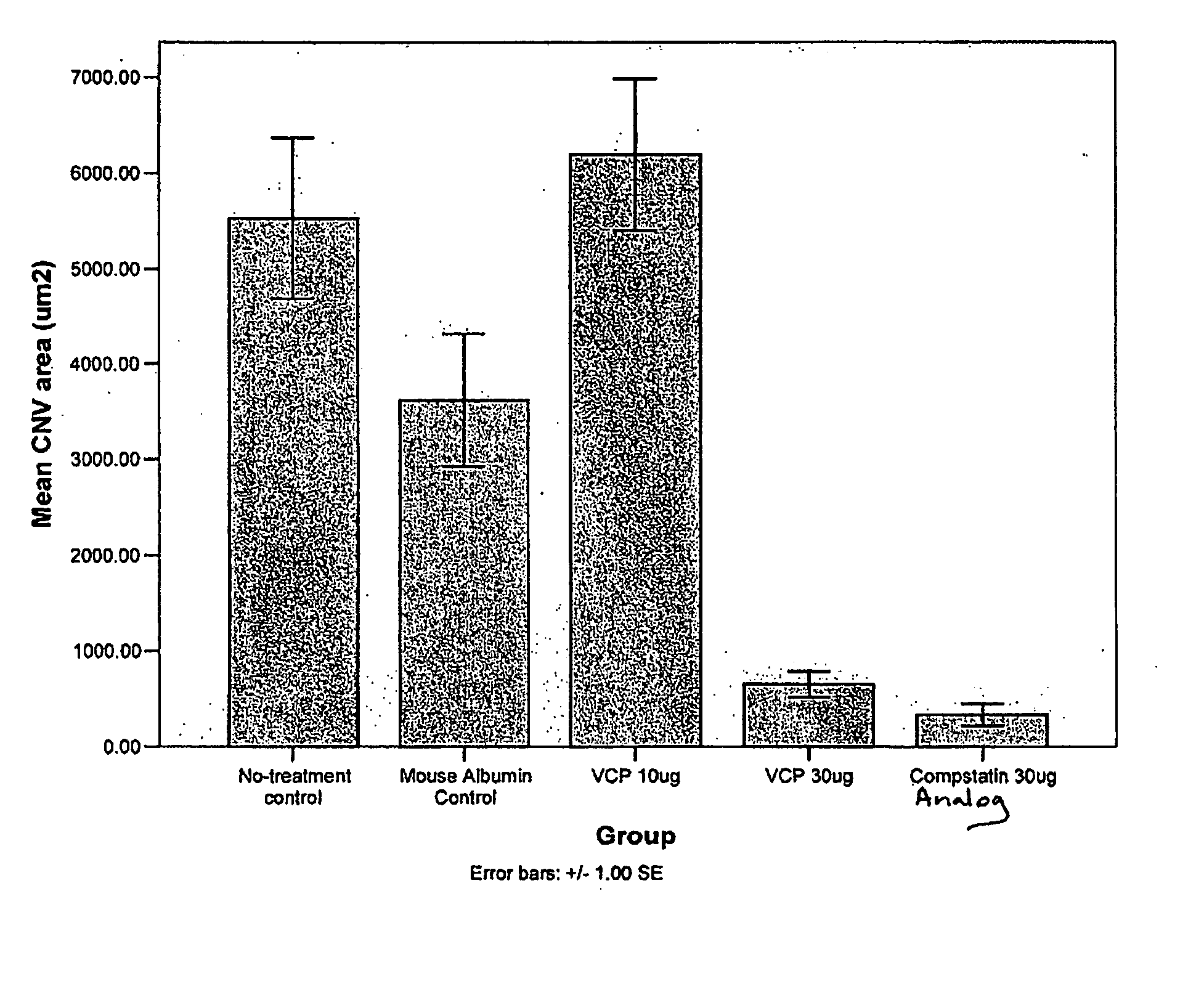Compstatin and analogs thereof for eye disorders
a technology of eye disorders and compstatin, which is applied in the field of eye disorders, can solve the problems of photoreceptor degeneration and slow and progressive deterioration of central vision in patients with this form of armd
- Summary
- Abstract
- Description
- Claims
- Application Information
AI Technical Summary
Benefits of technology
Problems solved by technology
Method used
Image
Examples
example 1
Prevention of Choroidal Neovascularization in a Mouse Model by Administration of a Compstatin Analog
[0295] Materials and Methods
[0296] Complement Inhibitors
[0297] Recombinant VCP was produced in and purified from a Pichia pastoris expression system as described in (Sahu, A, et al., J. Immunol., 160, 5596-5604, 1998). VCP was dissolved in physiological saline at various concentrations.
[0298] The compstatin analog shown in FIG. 2, in which positions 4 and 9 were altered relative to the compstatin peptide, was chemically synthesized and dissolved in physiological saline.
[0299] CNV Induction in Mice
[0300] C57BL / 6 mice (The Jackson Laboratory) were anesthetized with a mixture of ketamine / xylazine (8:1) and the pupils were dilated with a single drop of 1% tropicamide. Krypton red laser photocoagulation (50-μm spot size, 0.05 s duration, 250 mW) will be used to generate laser spots in surrounding the optic nerve by using a hand-held coverslip as a contact lens. Formation of a bubble ...
example 2
Prevention of Choroidal Neovascularization in a Mouse Model by Administration of a Compstatin Analog
[0307] Example 1 is repeated using a different compstatin analog. Doses ranging from 0.1-50 μg / eye are tested.
example 3
Preparation of Collagen Solutions for a Gel-Forming Composition
[0308] Stock Collagen Preparation.
[0309] Collagen for all formulations will be prepared from porcine corium. Split porcine hide will be procured from Lampire Biological Laboratories (Pipersville, Pa.). Split hide will be rinsed with reagent alcohol and placed in frozen storage prior to receipt. Sections of split corium will be cut into small pieces (about 1 cm2), soaked in reagent alcohol, and then washed extensively with sterile water. The washed pieces will be placed in 20 volumes of 0.5M HCl for 30 minutes, washed with sterile water and then placed in 20 volumes of 0.5N NaOH for 30 minutes. Both treatments have been shown to be effective in reducing viral titers by up to 6 logs. In addition, both treatments have been shown to have significant bactericidal effects, reducing bacterial loads by up to 9 logs. The chemically disinfected corium will be washed extensively in sterile water, weighed and placed in 20 volumes ...
PUM
| Property | Measurement | Unit |
|---|---|---|
| Time | aaaaa | aaaaa |
| Mass | aaaaa | aaaaa |
| Mass | aaaaa | aaaaa |
Abstract
Description
Claims
Application Information
 Login to View More
Login to View More - R&D
- Intellectual Property
- Life Sciences
- Materials
- Tech Scout
- Unparalleled Data Quality
- Higher Quality Content
- 60% Fewer Hallucinations
Browse by: Latest US Patents, China's latest patents, Technical Efficacy Thesaurus, Application Domain, Technology Topic, Popular Technical Reports.
© 2025 PatSnap. All rights reserved.Legal|Privacy policy|Modern Slavery Act Transparency Statement|Sitemap|About US| Contact US: help@patsnap.com



